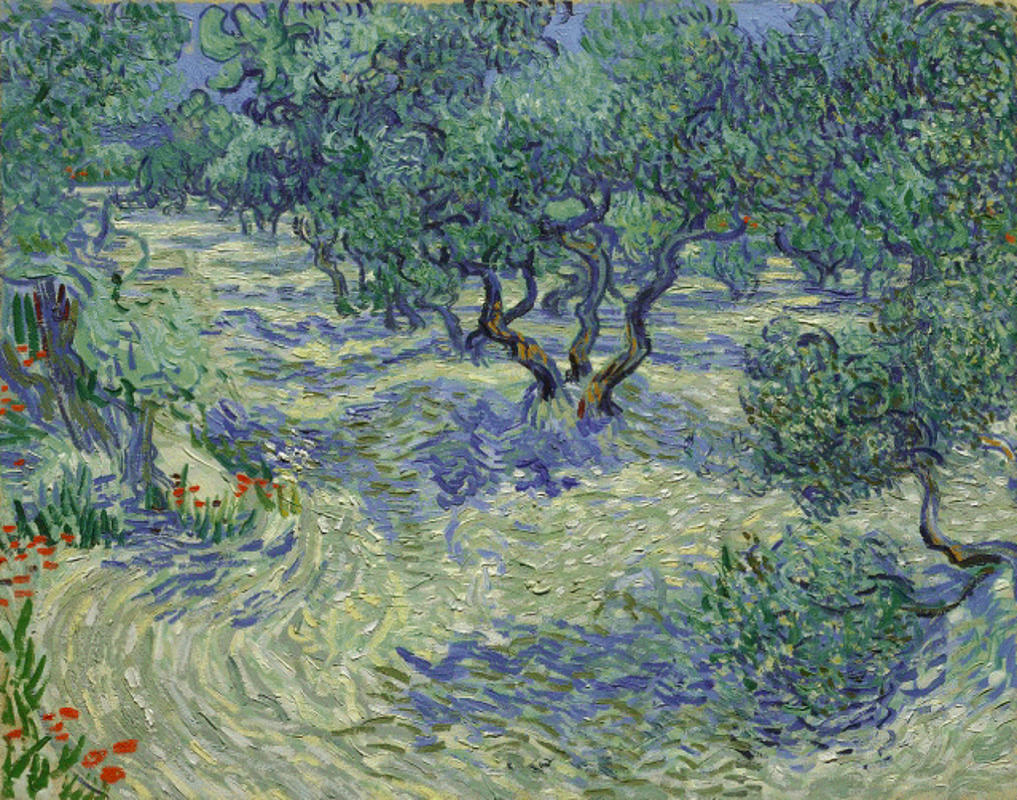More about Olive Trees
- All
- Info
- Shop

Contributor
After Van Gogh’s infamous ear incident, he entered an asylum in Saint-Rémy-de-Provence where he spent much of his time painting the surrounding nature, including olive trees as seen in this painting.
However, despite his productivity, his stay at Saint-Rémy was tumultuous, to say the least. During his time at the asylum, Van Gogh suffered a series of attacks and even attempted to end his life on one occasion. In a letter to Theo, he writes: “I no longer see any possibility for courage or good hope, but anyway it wasn’t yesterday that we found out that this profession isn’t a happy one.”
Van Gogh was first treated at Arles by Dr. Felix Rey, who believed the artist was suffering from epilepsy. Van Gogh remained in Dr. Rey’s care for a few weeks during which time the artist grew fond of the doctor’s kindness. Dr. Rey, who seemed to take an interest in Van Gogh’s art, was later presented with a portrait and a few other scenes of the hospital in Arles. Turns out Dr. Rey wasn’t crazy about Van Gogh’s style and gave the portrait to his mother. His mother wasn’t a fan either, declaring the painting hideous she used it to close the hole in the family’s chicken coop. Talk about savage, hopefully, news of that never made it back to the artist. He definitely would not have handled it well considering his state. Fortunately, the painting has made its way from the chicken coop to the Pushkin State Museum in Moscow. Started from the bottom, now it’s in Russia.
Under Dr. Rey’s care Van Gogh suffered another episode,and during this time the artist’s neighbors also filed a petition against him. Considering the circumstances, Dr. Rey recommended the artist try the asylum in Saint-Remy for treatment. At Saint-Rémy, Van Gogh was under the supervision of Dr. Theophile Peyron, who after seeing improvements allowed the artist to keep a studio space in the asylum and paint outside its premises. It was there Van Gogh began his series of olive trees. Later, he explained he wished to know “who [were] the human beings that [inhabited] the groves of olive trees." Like Millet’s harvest paintings with farmers, Van Gogh wanted to create a new iconic setting inspired by southern French landscape. Although he successfully painted in Saint-Rémy, he found the company in town too “idle and ignorant” to continue painting there.
Another reason he may have wished to leave Saint-Rémy could be the multiple attacks he suffered while at the asylum. According to Dr. Peyron’s notes, the artist tried to poison himself by eating oil paint and drinking turpentine after one of these attacks. Recently, this fact has dissolved into rumors that suggest Van Gogh ate yellow paint just to raise his spirits. He was sick y’all, not crazy. In addition to his illness, it appears Van Gogh’s anxiety also stemmed from the inevitable return of these attacks. Although he recovered enough to leave the asylum at Saint-Rémy, he never fully recovered as his anxiety and depression continued and culminated in his eventual suicide.
Sources
- “63/125 Did Van Gogh eat yellow paint thinking it would raise his spirits.” Van Gogh Museum. Accessed: January 4, 2017. https://www.vangoghmuseum.nl/en/125-questions/questions-and-answers/que…
- Khoshbin, Shahram, and Joel T. Katz. “Van Gogh's Physician.” Open Forum Infectious Diseases 2 (3). Oxford University Press, 2015. pg 1-2. Accessed: January 4, 2018. https://dash.harvard.edu/bitstream/handle/1/21461893/4539511.pdf?sequen….
- “On the Verge of Insanity.” Van Gogh Museum. Accessed: January 4, 2017. https://www.vangoghmuseum.nl/en/stories/on-the-verge-of-insanity#5
- Vincent van Gogh to Theo van Gogh. 22 August, 1889. In Vincent van Gogh: The Letters. Ed. Leo Jansen, Hans Luijten, Nienke Bakker, 2010. http://vangoghletters.org/en/let797
- Vincent van Gogh to Joseph Jacob Isaäcson. 25 May 1890. In Vincent van Gogh: The Letters. Ed. Leo Jansen, Hans Luijten, Nienke Bakker, 2010. http://vangoghletters.org/en/RM21
- Vincent van Gogh to Theo van Gogh. 1 May, 1890. In Vincent van Gogh: The Letters. Ed. Leo Jansen, Hans Luijten, Nienke Bakker, 2010. http://vangoghletters.org/en/let865















